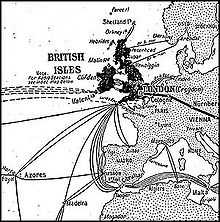Porthcurno Telegraph Museum
Coordinates: 50°02′35″N 5°39′14″W / 50.043°N 5.654°W

The Porthcurno Telegraph Museum is a museum located in the small coastal village of Porthcurno Cornwall, UK. Porthcurno was the point at which many submarine telegraph cables—transatlantic and to other locations—came ashore. The museum, which opened in May 1998, is housed in the former telegraph facility.[1]
History

The SS Great Eastern liner made by Isambard Kingdom Brunel was employed as a cable laying ship.[2] Its size made it the first choice to lay the original cables that linked the administrative outposts of the British Empire. The first European cable was not a success, its small diameter created too great a resistance to the voltage used and the signal was too weak to be reliable.[3] An attempt to increase the voltage pressure resulted in insulation breakdown and subsequent failure of the telegraph link.[4] The cables are heavily armoured for protection against damage as they come ashore, a lighter construction technique is used at depth on the ocean floor.[5] Modern cables are usually Fibre optic and are much lighter in construction, international information is now made available of the locations of submarine cables.[6][7] When the system was completed, central government in Britain had a method of effective communication with its civil servants and military commanders throughout the world.[8] At the outbreak of World War II, the existing surface installations were thought to be far too vulnerable to attack, and in 1941, miners were employed to cut tunnels into the solid granite of the valley's hillside to house the telegraphy equipment. Porthcurno telegraphy facility closed in 1970, 100 years after it first began its operations.
Museum development

The museum was started by former employees of Cable and Wireless based at the company's Holborn headquarters in London.[9] It is now located in the previously excavated tunnels near Porthcurno beach, Cornwall. The layout of the museum display was carried out after receiving a grant from the Heritage Lottery Fund.[1][10] The museum has displays showing the history of submarine cable-laying ships and telegraphy, and a variety of samples of cable designs used throughout its long history. The museum has a varied collection of still-working equipment designed for telegraphy.[11] It remained a training college for the communications industry until 1993. An Exeter University project known as "Connecting Cornwall" was funded to promote a new exhibition; "The Nerve Centre of Empire". This was opened in the summer of 2010 by HRH the Princess Royal.[12] The exhibition was developed as an educational experience for children and young people, employing original design from local artist, Hennie Haworth.[13] There are now around 15 people working at the museum, welcoming visitors from around the world and managing with a constant flow of research enquiries from academics, family historians, local historians and the media.[14] The most recent chapter in the museum's development involves the sensitive re-development of the Grade II listed buildings to accommodate greater exhibitions space, and improved visitor facilities including a cafe and greater accessibility. The project, 'Developing for the Future',[15] has been supported by Heritage Lottery Fund, the Arts Council England, Coastal Communities Fund, SubOptic, the Charles Hayward Foundation,. Department for Culture, Media and Sport/Wolfson Museums and Galleries Improvement Fund, ShareGift, the Edith Murphy Foundation, the Garfield Weston Foundation, The Headley Trust, Cornwall Council and the Trusthouse Charitable Foundation. Further funding was provided by the Clore Duffield Foundation for the development of a new, flexible educational centre; the Clore Learning Space. As a result of this extensive capital project, the museum closed to the public in September 2013 and reopened in summer 2014.
Museum staff and volunteers
The museum has around 16 professional staff, mostly full-time, and a large volunteer community. Many of the museum's technical volunteers trained or taught at the Porthcurno technical training college at some point in its history, prior to its eventual closure in 1993.
References
- ↑ 1.0 1.1 Godwin, Mary. "An Update on the Cable & Wireless Archive and Historical Collections" (PDF). BAC Newsletter (Business Archives Council) (141 Winter 2006). ISSN 0309-4200. Retrieved 2 February 2011.
- ↑ "Porthcurno Telegraph Museum". Brunel200.com 2006. Retrieved 10 January 2011.
- ↑ "Voltage, current & resistance". Porthcurno telegraph museum. Retrieved 9 March 2011.
- ↑ "About the collection at Porthcurno Telegraph Museum". Connected earth company – date undisclosed. Retrieved 9 March 2011.
- ↑ "Cableships (Past Exhibition)". Porthcurno telegraph museum – date undisclosed. Retrieved 9 March 2011.
- ↑ "About submarine telecommunication cables" (PDF). International Cable Protection Committee Ltd – date undisclosed. Retrieved 9 March 2011.
- ↑ "Cable databease". International cable protection committee. Retrieved 9 March 2011.
- ↑ "A Wire around the world". BBC Radio 4 science article 28 November 2005. Retrieved 9 March 2011.
- ↑ "Cable & Wireless archive". National archives – various dates. Retrieved 9 March 2011.
- ↑ "Memorandum by the Heritage Lottery Fund". Select Committee on Science and Technology Written Evidence. The House of Lords. 13 February 2006. Retrieved 2 March 2011.
- ↑ "Gallery". National education network 8 October 2007. Retrieved 29 March 2011.
- ↑ "Research & Knowledge Transfer". Exeter University – date undisclosed. Retrieved 9 March 2011.
- ↑ "The story of Insulation". Hennie Howarth 2011. Retrieved 9 March 2011.
- ↑ "Case study – The Porthcurno Telegraph Museum". Actnow broadband cornwall 2009. Retrieved 9 March 2011.
- ↑ "Telegraph Museum Porthcurno development blog". Telegraph Museum Porthcurno development blog. Telegraph Museum Porthcurno.
External links
| ||||||||||||||||||||||||||